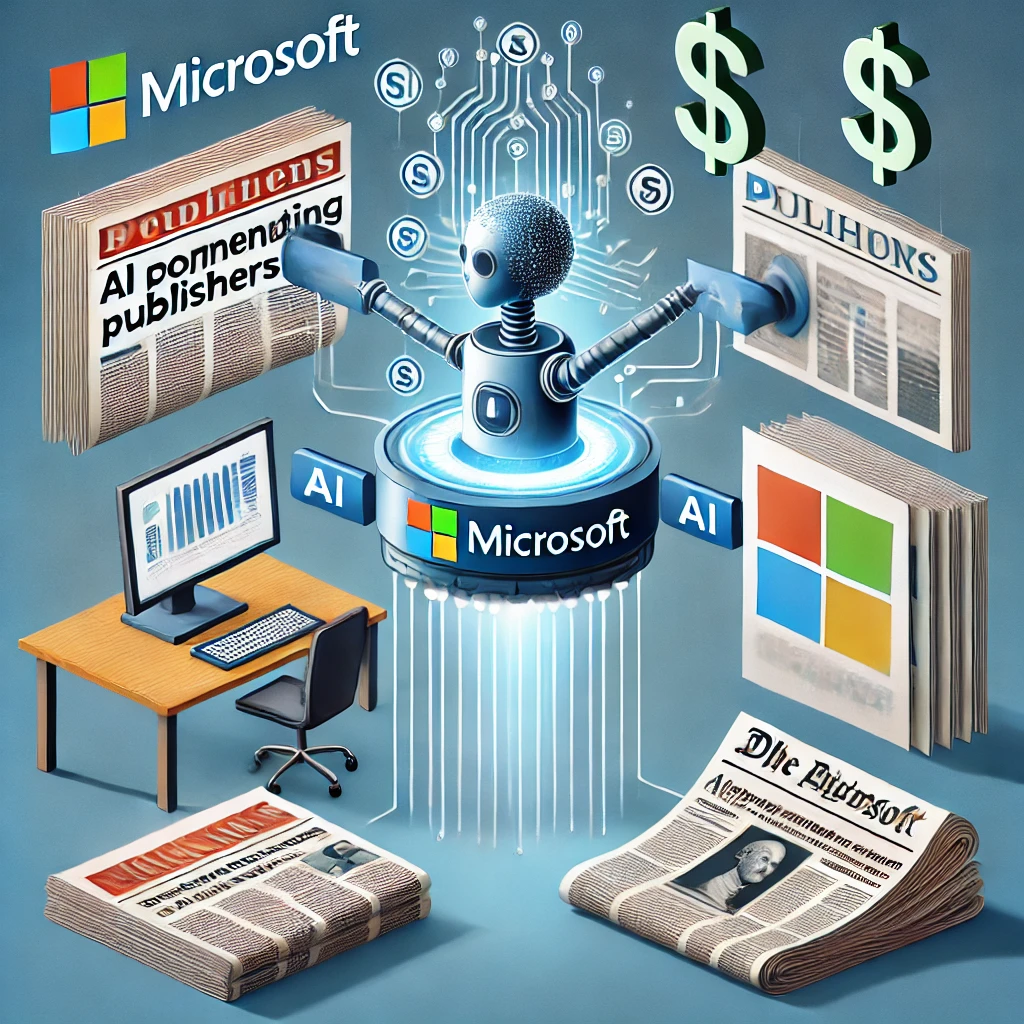Blog
Microsoft Plans to Pay Publishers for Content Used by Copilot Daily

In a move that aims to address growing concerns over the use of copyrighted material in artificial intelligence, Microsoft has announced plans to compensate publishers for content utilized by Copilot Daily, its new AI-powered information and content aggregation service. This marks a significant shift in the approach of major tech companies to handling intellectual property within generative AI tools, setting an important precedent for the tech industry as it navigates the ethical and legal challenges of using online content for AI training and responses.
What is Copilot Daily?
Copilot Daily is one of Microsoft’s latest features, integrating artificial intelligence to deliver real-time news, information, and summaries directly to users via its various productivity platforms, including Microsoft 365 products such as Teams, Outlook, and Word. Essentially, Copilot Daily acts as a digital assistant that brings curated news and relevant information directly to users’ workspaces, thereby keeping them informed without leaving the workflow environment.
This service utilizes AI technology to generate briefings based on the latest news and provides summaries drawn from a wide variety of sources, including mainstream media outlets, niche blogs, and social platforms. However, the aggregation of this content without compensation to publishers has raised significant concerns among news media companies, which rely on the monetization of their work through subscriptions, ads, and syndication fees. In light of these concerns, Microsoft’s announcement represents a response to mounting pressure from publishers and a proactive effort to build a sustainable partnership model for content use.
Microsoft’s Compensation Plan: A Win for Publishers?
Microsoft’s new compensation plan proposes to pay publishers when their content is used or referenced by Copilot Daily. This model will include licensing agreements with media organizations, providing them with a financial incentive when their content is accessed or summarized by the AI tool. The company has indicated that it will reach out to news organizations directly to establish formal agreements, focusing initially on partnerships with larger publishers before expanding to smaller, independent media outlets.
Brad Smith, President of Microsoft, commented on the initiative: “We believe that AI should create opportunities, not challenges, for news publishers. By compensating publishers for the value their content brings to Copilot Daily, we are committing to a fair approach that recognizes the essential role of quality journalism in our society.”
Microsoft’s plan aims to create a balanced ecosystem where content creators are rewarded for their contributions, mitigating fears that AI tools like Copilot might harm the news industry by extracting value without proper compensation. The new compensation framework could resemble that of subscription fees or syndication royalties, whereby Microsoft pays on a per-usage or per-access basis depending on the frequency with which Copilot Daily draws from a specific publisher’s content.
Why This Matters for the News Industry
The rise of generative AI tools has sparked significant debates in the media world, particularly about the ethics of using existing content without proper attribution or compensation. News outlets, which invest heavily in gathering, verifying, and reporting information, have voiced concerns that tools like ChatGPT, Bard, and other AI content aggregators often use their content to generate insights without any revenue returning to the original creators. The financial model of journalism relies heavily on advertising, subscriptions, and licensing, all of which have been impacted by the way AI can freely extract and recombine information.
For publishers, the introduction of compensation plans by a major player like Microsoft could potentially pave the way for other tech giants such as Google and Meta to follow suit. This move could lead to a more structured relationship between AI developers and content creators, ensuring that newsrooms are compensated when their reporting is leveraged by AI services to inform the public.
The News Media Alliance, a group that represents publishers and media companies globally, has welcomed Microsoft’s decision. According to their spokesperson, “This is a significant step in the right direction. Our members work tirelessly to provide the kind of high-quality journalism that informs and empowers society. Ensuring compensation for their work when used by AI is crucial for the sustainability of the news industry in the digital age.”
A Model for Future AI and Publisher Partnerships
Microsoft’s approach could set a template for how the broader industry tackles the challenge of AI and intellectual property. For instance, Google, which also faces scrutiny over its AI services like Bard that extract information from news sites, has yet to announce a comparable plan. The tech industry has long benefited from using internet content as a training base for its algorithms, but the impact on original content creators, particularly in journalism, has often been sidelined.
Microsoft has also highlighted that the payments will not be a flat licensing fee but will be performance-driven. This means that if Copilot Daily pulls extensively from a particular publication that users find valuable, the associated publisher would receive greater compensation. This performance-based model could encourage news organizations to provide timely, relevant content, knowing that their engagement with audiences through AI tools could directly translate to additional revenue.
Technical and Practical Challenges
There are, however, challenges ahead for Microsoft in implementing this plan. One of the critical aspects will be determining which content qualifies for compensation and how usage is measured. AI-generated summaries often pull information from multiple sources to provide comprehensive insights, which complicates attribution. Microsoft will need sophisticated tools to track exactly which publishers are contributing to each AI response and fairly distribute payments based on the contribution level.
Additionally, the plan raises questions about how smaller, independent publishers will be integrated into the system. Will they receive equitable compensation compared to large media conglomerates that have more influence in negotiation processes? Microsoft has stated its commitment to working with all types of publishers, but the real impact will depend on how inclusive and transparent the licensing agreements are.
Potential Reactions and Industry Impact
The announcement has elicited mixed reactions across the industry. While many publishers see this as a step forward, there are concerns about the details of the licensing agreements, including how fair and consistent the compensation will be, particularly for smaller outlets. Moreover, advocacy groups are calling for greater transparency in how AI tools aggregate and utilize content, and for more stringent standards that would hold tech companies accountable when leveraging journalistic content.
Meta and Google—both of which operate their own AI and content distribution services—are now under pressure to provide similar assurances to publishers. Meta has previously faced backlash over its use of news content without sufficient compensation, leading to regulatory disputes in countries like Australia and Canada. These tensions have underscored the necessity for clearer, more equitable systems that can ensure that content creators are not sidelined in the age of AI.
For journalists, the promise of compensation is a positive signal, suggesting that their role remains integral to information dissemination even as AI becomes more prevalent. However, some are concerned that the focus on performance-based compensation could drive AI to prioritize certain types of content that are more “engaging” but not necessarily of higher journalistic value, such as sensational headlines or superficial summaries.
The Road Ahead: Shaping AI-Content Partnerships
Microsoft’s decision represents a proactive approach to mitigating one of the most contentious issues surrounding generative AI. As AI becomes more integrated into the way people access information, establishing a fair compensation model for content creators is not just beneficial for publishers but also crucial for the long-term sustainability of high-quality, independent journalism.
The success of this plan will hinge on the transparency of Microsoft’s licensing agreements, the inclusivity of compensation models, and the willingness of other tech companies to adopt similar practices. If successfully implemented, it could provide a framework for a mutually beneficial relationship between AI developers and content creators—a necessary step as AI continues to evolve and impact industries across the globe.
Microsoft has positioned itself as a leader in ensuring fair use of journalistic content by AI tools, and its move is likely to be closely watched by regulators, publishers, and other tech firms. As the tech and news industries find common ground, this could represent the beginning of a new era of collaboration that ultimately benefits both AI users and the creators of the content that feeds these powerful tools.
For further information on Microsoft’s plan and its implications for the news industry, you can read more on Microsoft’s official blog and related analyses on TechCrunch.
Blog
Morocco Sets Sights on 70% 5G Coverage by 2030 With New License Launch

RABAT — July 26, 2025
In a landmark step toward digital transformation, Morocco’s National Telecommunications Regulatory Agency (ANRT) has officially launched the bidding process for 5G licenses, inviting national and international telecom operators to help deliver 25% population coverage by 2026 and 70% by 2030.
5G Strategy to Power FIFA World Cup and Beyond
The initiative aligns with Morocco’s preparations to co-host the 2030 FIFA World Cup and its broader Maroc Digital 2030 agenda. “This is about more than faster networks—it’s about our national future,” said Driss El Yazami, policy advisor at the Ministry of Digital Transition.
Highlights of the 5G Deployment Plan
- Initial rollouts in Casablanca, Rabat, Marrakech, and Tangier
- Smart infrastructure integration in stadiums and airports
- Spectrum allocation in 3.5GHz and mmWave bands
- Coverage expansion to underserved rural regions
From Urban Startups to Rural Farmers: 5G’s National Reach
5G is expected to revolutionize Moroccan society. Students will gain access to virtual classrooms, remote clinics will offer telemedicine, and farmers can deploy smart sensors. “Connectivity is empowerment,” said Amina El Mahdi, a tech entrepreneur in Fez.
Economic Impact and Cybersecurity Measures
The Ministry of Finance predicts 5G will boost GDP by 1.5% by 2030. All operators must meet strict cybersecurity, data localization, and interoperability standards monitored by ANRT and the National Cybersecurity Directorate.
2030 World Cup: Smart Stadiums and Global Broadcasts
With over 1.5 million visitors expected, 5G will support crowd management, mobile ticketing, HD broadcasts, and fan engagement zones across Moroccan host cities.
5G infrastructure being deployed in Morocco’s major cities ahead of FIFA 2030.
Blog
Critical Cyber Breach in Tunisia: Government Systems and Banks Hacked, Confidential Data for Sale

A coordinated cyberattack led by Moroccan hacker Jokeir 07x and groups Dark Hell 07x and Dr. Shell 08x compromises key Tunisian institutions, exposing government systems, banking infrastructure, and personal data to global exploitation.
Tunis, July 2025 — In an alarming escalation of cyber threats across North Africa, Tunisia has become the latest victim of a highly organized and devastating cyberattack. Orchestrated by Moroccan threat actor Jokeir 07x, in partnership with the groups Dark Hell 07x and Dr. Shell 08x, the operation has compromised critical national infrastructure—from government domains to private financial institutions.
“This is not just a defacement campaign—it’s full infrastructure penetration,” declared Jokeir 07x on Telegram.
The targets include the Ministry of Finance, Bank of Tunisia, BTK, and the Tunisian Academy of Banking and Finance, among others. The attackers claim full access to internal systems, including emails, financial records, developer platforms, and sensitive citizen data.
🏛️ Government Domain Breached: Ministry of Finance
The domain finances.gov.tn was infiltrated through 16 high-risk subdomains such as auth., gitlab.intra., mail., and login-tej. According to hacker statements, these allowed access to:
- Internal recruitment systems
- Budgetary information
- Developer repositories
- Administrative emails
This level of penetration indicates control over Tunisia’s digital authentication infrastructure and DevOps environment, raising severe concerns for national cybersecurity.
🏦 Banking Sector Compromised and Data Sold
Several banks were also impacted:
- Bank of Tunisia (bt.com.tn):
- Full customer database allegedly available for $4,000
- Individual bank accounts offered at $100
- 5-account bundles sold for $450
- BTK Bank (btknet.com) and Academy of Banking and Finance (abf.tn) also suffered complete breaches, including control over the sites and underlying systems.
The incident signals not just a data breach but the active commercialization of sensitive financial information on the dark web.
🔍 Technical Breakdown: How It Happened
Cybersecurity analysts have pointed to multiple failure points within Tunisia’s digital infrastructure:
- Web Application Vulnerabilities:
- SQL Injection
- File Upload flaws
- XSS
- Remote File Inclusion (RFI)
- SSO and Mail System Exploitation:
- Session hijacking likely
- Weak session/cookie management
- GitLab Exposure:
- Unauthorized access to internal GitLab revealed API tokens, credentials, and system architecture
- Lack of Security Infrastructure:
- No evidence of WAF, IDS, or SIEM defense
- No active monitoring or response systems
- Inadequate Data Protection:
- Absence of encryption, data masking, or tokenization
- Entire banking datasets available in plain text
⚠️ The Fallout: Trust, Security, and Reputation
This attack lays bare the vulnerabilities in Tunisia’s cyber defenses, damaging public trust in both government institutions and the banking sector. The country’s financial and administrative data has now surfaced on international black markets, with potential long-term repercussions for national security and economic stability.
💡 Urgent Recommendations for Recovery and Reform
Cybersecurity professionals are urging Tunisia to immediately:
- Establish internal SOC (Security Operations Centers)
- Mandate routine penetration testing
- Enforce multi-factor authentication (MFA)
- Implement end-to-end data encryption
- Audit and secure GitLab instances
- Conduct staff training on social engineering threats
- Deploy real-time code and data monitoring
“Being hacked is not the shame—failing to learn from it is,” noted a Tunisian cybersecurity analyst. “The future belongs to those who invest in digital resilience, not legacy infrastructure.”
Blog
Cloud Wars 2025: Full Breakdown of Azure, AWS, and Google Cloud Services You Need to Know
As cloud computing reshapes digital infrastructure, this side-by-side comparison of services across Microsoft Azure, Amazon Web Services (AWS), and Google Cloud Platform (GCP) empowers IT professionals and organizations to make informed decisions.
Cloud Wars: Breaking Down the Giants
In today’s digital-first world, cloud computing isn’t just a trend—it’s the backbone of enterprise IT. Whether you’re a startup deploying an app or a global corporation migrating legacy systems, choosing the right cloud provider can make or break your operations. A newly circulated Cloud Services Comparison Cheatsheet provides an invaluable visual breakdown of offerings from Microsoft Azure, Amazon Web Services (AWS), and Google Cloud Platform (GCP), the three dominant players in the cloud arena.
Technical Deep Dive: Key Service Categories Compared
This infographic categorizes over 25 essential cloud services and maps each across Azure, AWS, and GCP equivalents. Here’s what stands out:
1. Compute Services
- Azure: Virtual Machines
- AWS: EC2 (Elastic Compute Cloud)
- Google Cloud: Compute Engine
These services provide scalable virtual server environments, with options for predefined or custom machine types. Azure and AWS offer more mature ecosystems with hybrid cloud integrations, while GCP emphasizes fast boot times and sustained-use discounts.
2. Object Storage
- Azure Blob Storage
- Amazon S3
- Google Cloud Storage
All three services allow you to store large amounts of unstructured data. AWS S3 is known for its advanced features (like S3 Glacier), while Azure Blob integrates well with Microsoft services, and GCP offers multi-regional redundancy by default.
3. Serverless Computing
- Azure Functions
- AWS Lambda
- Google Cloud Functions
Serverless solutions allow developers to execute code without managing servers. AWS Lambda leads in ecosystem maturity, while Azure and Google offer solid integrations with their respective developer tools.
4. Content Delivery Networks (CDNs)
- Azure CDN, AWS CloudFront, and Google Cloud CDN
All three platforms offer global distribution of content to reduce latency. AWS CloudFront is widely adopted in large-scale enterprise environments, while Google leverages its backbone network to deliver high-speed content.
Security & Identity Management
Cloud security remains a priority as data breaches and compliance requirements escalate.
- Identity and Access Management (IAM) is offered across platforms with Azure Active Directory, AWS IAM, and Google Cloud IAM.
- Key Management Services (KMS) ensure secure handling of encryption keys across all three.
- Compliance tools like Azure Trust Center, AWS Cloud HSM, and Google Cloud Security help enterprises adhere to global regulations like GDPR, HIPAA, and ISO/IEC.
Specialized Services: AI, Containers, and Analytics
- Analytics: Azure Stream Analytics, Amazon Kinesis, and Google Dataflow enable real-time data processing.
- Containers: Azure Kubernetes Service (AKS), Amazon EKS, and Google Kubernetes Engine (GKE) support modern container orchestration.
- Automation: Each provider supports automation—Azure with Azure Automation, AWS with OpsWorks, and GCP with Deployment Manager.
Notable Differences
Some categories reveal gaps:
- Google Cloud lacks direct equivalents for services like DNS management (Route 53, Azure DNS) or cloud notifications (AWS SNS, Azure Notification Hub).
- Azure leads in hybrid cloud features due to its integration with Windows Server and on-prem tools.
- AWS offers the broadest service portfolio, making it ideal for complex multi-cloud or global enterprise setups.









